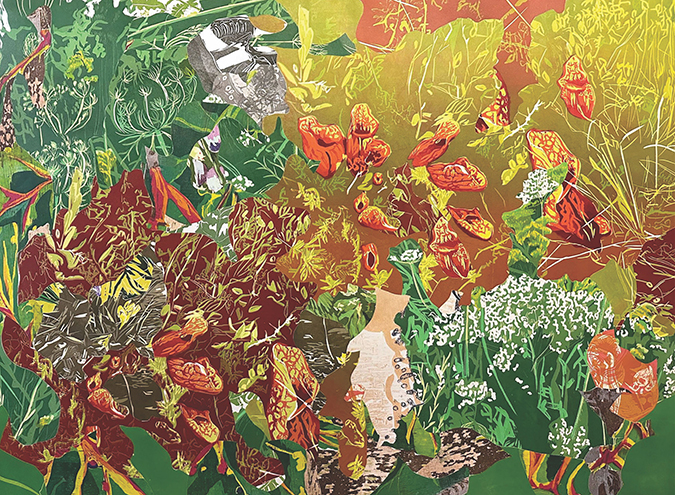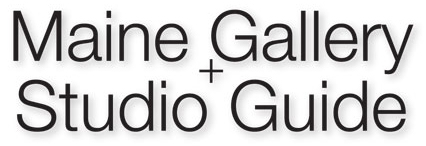
The Zillman Art Museum, University of Maine, located at 40 Harlow St. in downtown Bangor, opens new exhibitions that will run through Dec. 2 (second floor galleries) and Dec. 30 (main floor galleries).
SUSAN ABBOTT: “An Artist’s Pilgrimage: Paintings from the Camino De Santiago”
Sept. 15 to Dec. 2
The Zillman is pleased to present a solo exhibition of paintings by Vermont-based artist Susan Abbott. These works document the artist’s walk along the Camino de Santiago from Saint-Jean-Pied-de-Port in the French Pyrénées to the Santiago de Compostela in Spain. This two-month long trek, carrying a 16-pound backpack that included sketchbooks, painting supplies and her journal, was a transformative experience for Abbott. The Camino was one of the most important spiritual roads of the Middle Ages, leading to the shrine of the apostle James in the Cathedral of Santiago de Compostela in Galicia. Today it remains one of the world’s great pilgrimages.
The immense undertaking of documenting the nearly 600-mile Camino de Santiago in art reflects the rigor of the walk itself. Abbott’s paintings mirror the Camino’s changing terrain, from mountains to meadows and along rocky trails, dirt paths, and asphalt roads. Abbott’s work is dominated by her bold use of color, injecting each scene with emotion and vitality. The hues and tones used are as unique as Abbott’s interpretation of the landscape that she witnessed. In this exhibition, Abbott invites the viewer to join the expedition and meander through each scene. The paintings are hung in chronological order from right to left so as you walk through the galleries you will follow the same path across Spain as the artist and share some of the journal entries and poems she created while on the Camino.
“This pilgrimage has given me a heart full of images, emotions, colors, and mysteries. Over the coming years, all of these will find their way into my paintings and my life.”
Susan Abbott graduated with a BA and MFA in painting from the Maryland Institute College of Art. She has worked as a professional artist since that time, exhibiting in galleries and museums across the country.
JOHN WOOLSEY: “Distant Visions”
Sept. 15 to Dec. 30, 2023
“Distant Visions” showcases over 70 works by Philadelphia-based artist John D. Woolsey. The exhibition provides a glimpse into Woolsey’s multi-faceted creative process that involves cycles of deconstruction and renewal. The artist’s woodcut prints are cut up or dissected into bands and shard-like shapes, then refashioned into new compositions. These excerpted visual elements are often repeated in multiple compositions and integrated with other components to create a new experience.
A focal point of the exhibition is Woolsey’s massive wall installation that incorporates an array of restructured prints. The inventively-shaped works—brought together in the 15 foot installation — include fan-shaped designs, tondos, and formats that resemble circular saw blades. The artist states that the imagery in his woodcuts are “transformed from my drawings, where I’ve documented light seen through woods; sky, and forest reflected in water; microscope-viewed cross sections of wood or other plant material.”
Woolsey’s time spent on the Maine coast observing the environment and woodland flora has had a profound impact on his work. His prolonged contemplation of trees, rocks and foliage result in depictions that embrace complexity and age. Woolsey comments, “The process of transformation and the multiple scales of time (human, historical, geological) has been an emphasis in this body of work.”
AMANDA LILLESTON: “deep fields”
Sept. 15 to Dec. 30, 2023
Maine-based artist Amanda Lilleston explores biological narratives through woodcut printing and collage in her exhibition deep field. The prints highlight the concept of transformation, depicted in burgeoning colors of flora. Lilleston began this body of work about ten years ago – the idea stemming from, “a broader, general interconnectedness of systems: biological, physiological, and ecological.”
The themes that permeate her artwork reflect Lilleston’s educational and life experience, as well as motherhood. The artist explains that she has become, “acutely aware of my body being part of a larger environment.” Lilleston thoughtfully examines these natural subjects to allow for adaptation and change within the imagery. Modification of the printmaking is emulated in the reduction printing process whereby the artist repeats the process of carving and printing until the final look is achieved. Lilleston makes further alterations by cutting and combining the printed pieces in new ways. Upon closer inspection viewers may notice that some of the same botanical forms appear as collaged elements in multiple compositions. The vibrant use of vivid greens and radiant reds fill these representations with energy and life.
Lilleston earned her BA in biology at Colorado College and received her MFA from the University of Michigan.
“THEN TO NOW: PAINTINGS FROM THE COLLECTION”
Sept. 15 – Dec. 30, 2023
“Then to Now” features paintings from the ZAM’s permanent collection, 1864 to present, that document the passage of time and place through mostly realistic, nature-inspired paintings. These works invite a comparison of historical approaches of landscape painting to more contemporary depictions of the environment.
The earliest work represented, “The Elm,” was painted in 1864 by George Inness. Inness was one of the key figures of the Hudson River School. This idyllic and atmospheric landscape is a romantic interpretation of a scene that the artist painted throughout his career. His use of diffused light and subdued tones created the pastoral perspective. Alfred Thompson Bricher (Coast Landscape, 1878) was also associated with the Hudson River School which was one of the first cohesive American art movements.
One of the 20th mid-century works highlighted is the watercolor painting by Andrew Wyeth, On Bar Island. Wyeth’s muted colors and shadowy light imbue the paintings with mystery and stillness. Another artist of this period with connections to Maine was Carl Sprinchorn. “Stormy October Sunset — Shin Pond, 1946,” a scene depicting cloudy skies over water is painted with gestural marks and a turbulent palette.
Many contemporary paintings in the exhibition share the landscape narrative of the older works but execute the vision differently. In the verdant pastoral painting, Merrymeeting Bay, 1970, Thomas Cornell explored the process of composition by using perspective lines as a dynamic visual device. In contrast, Dozier Bell creates an abstracted, moody, and tempestuous reflection of place with Map #7, 1995.
The breadth of style and technique on display in this exhibition is as diverse as the artists themselves. The artwork provokes the viewer to contemplate, “what makes a landscape?”
DOUBLE TAKE: SELECTIONS FROM THE COLLECTION
Sept. 15 to Dec. 2, 2023
As one moves through the world, what impulse compels us to turn around and take a second look? The works featured in Double Take encourage the viewer to slow down, have a deeper look, and perhaps even suspend disbelief. The human tendency to process information quickly and move on is hard to suppress even during a leisurely stroll through a museum. However, when employing a quick-read approach, one is likely to miss the details, subtleties, non-traditional use of materials and creative approaches that may complicate expectations.
Why is a ripped, dusty, decaying piece of cardboard and a crushed metal dust pan hanging on the gallery wall? Viewed within the context of contemporary art, these pieces might be inspired by Marcelle Duchamp’s ready-mades or some sort of conceptual experiment. Richard Haden’s hyper-realist sculpture Colonizing Corrugation is so well-crafted — with its meticulously painted surfaces — that it’s hard to believe that what appears to be a heavily-weathered cardboard sheet is actually carved mahogany. Likewise, in Panhandler, a mangled dustpan is carved from poplar and then painted to resemble aluminum complete with surface scratches from heavy use.
Upon first glance, Cayce Zavaglia’s Raphaella II may appear to be a finely-executed oil portrait of a young girl, but in reality the composition has been painstakingly embroidered using an array of colored thread. In addition, things are not as they appear to be in Lori Nix’s photograph Bar, 2009. The shuttered neighborhood watering hole has seen better times, but in actuality the entire scene is a hand-crafted miniature diorama. Every item, from the overturned barstools to a grouping of taxidermy animals, has been meticulously sculpted by Nix.
When attentively looking at Maya Brodsky’s realist painting Curtain one might notice an unexpected element. The faint images of legs enter from the right of the composition like an apparition. Could it be the afterimage of the elderly man’s loved-one?
“Double Take” reminds us to engage in active looking, to adjust our pace, question materials, imagery and process.
ZAM is open from 10 a.m. to 5 p.m. Tuesday through Saturday. Admission is free. See zam.umaine.edu for details.

